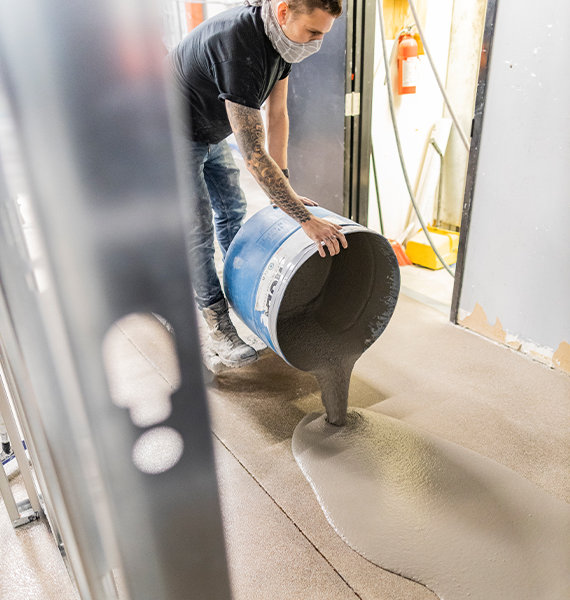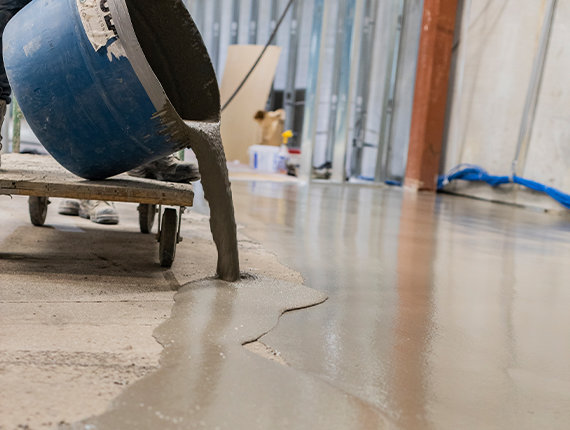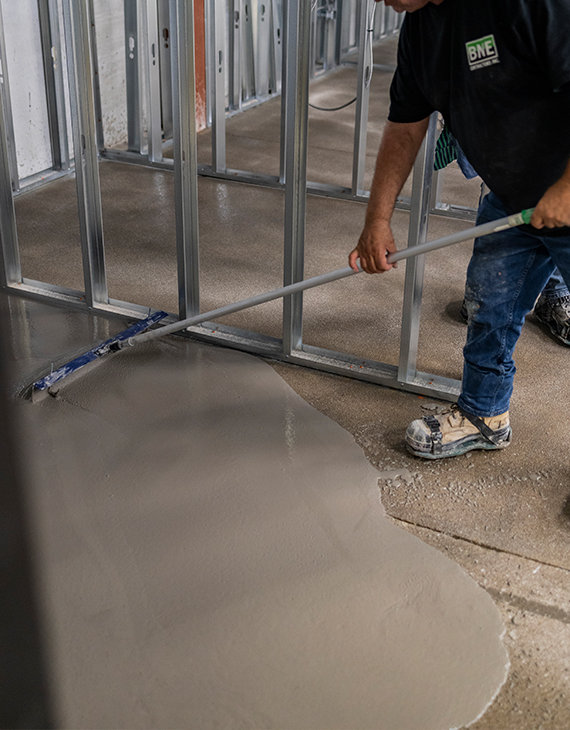Underlays and overlays have gained popularity over the last twenty years and are being used more and more by professional concrete floor contractors like BNE.
Cementitious self-leveling overlays, also known as concrete toppings, go over top of an existing concrete structure to provide a new concrete surface which then can be finished, saw-cut, acid stained, dyed, sealed, coated, engraved, and even polished. Installed at only 6-9 mm thickness they are much lighter than conventional 50-75mm toppings which can reduce the cost of having to do structural re-enforcing or reducing door heights and existing elevations.
Self-levelling underlays also go over top of an existing concrete slab and provide a flat, level surface that is ready for installation of a finished flooring product such as tile, vinyl, or hardwood.
Like concrete, they are cementitious, but they contain much finer aggregate. Underlays and overlays are different from concrete in that they have added chemical components. Concrete is typically made of four ingredients: sand, rock, cement, and water while an overlay can have 10 to 20 ingredients.
Even the most perfectly poured concrete can have 3/8 of an inch variation in flatness and sometimes up to ½ inch over a 10’ or 12’ slab. A cementitious, self-leveling product can correct that difference and give you a perfectly level and flat floor.

There are several differences between an overlay and an underlay.
Underlays go underneath the final flooring to create a smooth layer between the subfloor and the finished floor to improve levelness and adhesion.
Overlays go on top of the subfloor, but they are the final wear surface.
Underlays must be covered because they can easily scratch, chip, and crumble with minor impact. Overlays have much higher quality ingredients to allow them to be used as the final wear surface and to resist damage.
Underlays have 2500 to 3500 psi in compressive strength while the hardness of overlays is closers to 5000 to 6000 psi. Underlays also have 30-50% less flexural strength than overlays.
Underlays can be installed to a maximum thickness of one inch while self-leveling overlays can be installed to maximum thickness of two inches. If you have a floor that is more off-level by more than one inch, you will have to use an overlay even if a finished floor would be installed on top.
Both overlays and underlays need a coating of primer for adhesion and moisture mitigation. Overlays require the use of a higher quality primer like epoxy and a more complicated application involving multiple coats and broadcast sand to create a stronger bond and prevent bubbles.
Finally, underlays use lower quality ingredients, and the final cured look doesn’t matter so they are less expensive than overlays.
Restoring an aged or damage concrete floor used to mean demolishing the existing slab and then having to pour a new one. Now a damage floor can be covered in overlay and then finished to look brand new. The cementitious overlay strengthens your floor structure, making two times more resistant to impact damage than concrete itself.
Because of their ease of installation and versatile finishing options, overlays can be use in many industrial and commercial flooring applications. Overlays are great for any of the following and more:
Residential buildings
Restaurants
Hotels
Shopping malls
Casinos
Car dealerships
Resorts
Banquet halls
Office buildings
Retail stores
Museums
And light industrial applications
Speak with your expert BNE representative to discuss which flooring option is the best solution for your flooring project.
You can have projects where areas are different; one room was tiled, one room had vinyl, one room was exposed concrete, some of the slabs have different ages, and some have pre-existing conditions such as slopes for drainage or backfilled mechanical trenches. Experienced concrete flooring contractors know that a huge advantage to using an overlay is being able to apply a consistent finish across different flooring and substrates.
Overlays give a hard, cured, concrete finish within hours or days. In fact, you can have foot traffic on the surface in four to six hours and contractor traffic the next day. A fast-drying time means you can have your other trades in to start their work with minimal downtime.
If your overlay will be finished by polishing, you don’t need to waste days waiting for it to dry. Your contractor can start polishing twelve to fifteen hours after pouring.
Cementitious self-leveling overlays cannot be used on vertical surfaces, usually need to be used on interior floors, and they are not suitable for certain industrial applications such as steel-wheeled traffic or harsh chemical environments. They also cannot be stamped like concrete and there is no way to tape off designs the way you can with concrete.

There are a wide variety of overlays from different manufacturers and it’s important that your contractor has expertise and training in the overlays they are using. Some overlays are made with sand, cement, and a binding polymer and others can include gypsum, blended cement, special modifiers, and superplasticizers.
These modifiers increase the tensile strength and flexural strength of the overlay and improve its durability in different scenarios.
For example, gypsum is added to some overlays to increase its performance when installed on wood flooring. But some brands may need a plastic or metal lath over the wood and others can be poured directly on top.
Regardless of all these possible options, all overlays need to be installed on a clean and properly prepared surface – free of any oil residues or anything other chemical that can interfere with correct bonding.
Self-leveling overlays seem to have a deceptively easy installation process; in that they are just poured or pumped out onto the floor and then distributed using a spreader. But expert installers know that there are a lot of things that can go wrong.
Your contractor will need to know the product they are working with and understand the manufacturer’s installation instructions. BNE works very closely with the product manufacturers we use, and we know our products inside and out.
The concrete floor still needs preparation for the overlay or underlay to adhere properly. BNE makes sure that all cracks are fixed, joints are caulked, and any heavily damaged areas are brought up before application of the self-levelers.
In most cases, we would also prep the floor by roughing up the concrete through grinding or shot blasting then prime the surface with an epoxy primer for moisture mitigation.
When installing an impermeable flooring on top of a concrete pad, you must wait for the slab to dry out before you can install the floor. Unfortunately, it can take months for a concrete pad to properly dry and reach an internal humidity of less than 5 percent. Common practice to install gypsum or cementitious toppings over hollow core slabs to reduce the cost of finishing, expedite schedule.
We can use a self-leveling underlay to avoid this. By leaving room below the final elevation, the floor can be screed off. Screed is a blend of cement and sharp sand, and can be poured over the concrete, giving you a level and flat floor to install the finished flooring.
By adding an epoxy-based coating, we can also prevent moisture wicking up from the concrete, a process known as moisture mitigation.
An underlayment can be installed directly over top of the broadcast epoxy, but sometimes it may require a primer to penetrate the substrate and vastly improve the bond.
Our experts only use the best solution for your specific project. For example, our team knows to use a low alkali underlayment to prevent the underlay damaging or interfering with floor adhesives needed for tiles, vinyl, or other floor finishes.
The popularity of self-levelling underlays has resulted in many improvements over the last 15-20 years. Underlayment can now be mixed and delivered in large amounts by truck, reducing the cost, mess, and improving efficiency of installation.

When it comes to concrete self-leveling products it’s important that you hire a contractor that has the right tools and the right expertise for the project you have.
Speak with a Sales Rep to discuss your project today.
CONTACT OUR SALES REP
Concrete floor leveling overlays and underlays use finer aggregates and special components, offering a stronger, more consistent surface and quicker curing than traditional concrete.
Overlays can be installed up to 2 inches thick, providing a strong final wear layer, while underlays can be applied up to 1 inch to level the floor for finished flooring.
No, underlays used in concrete floor leveling are not intended as the final surface, as they can scratch or chip easily and are designed to be covered with a finished floor.
Overlays are versatile and ideal for interior horizontal surfaces but are not recommended for areas exposed to harsh chemicals or steel-wheeled traffic.
Concrete floor leveling overlays cure quickly, allowing foot traffic in 4-6 hours and contractor access by the next day. Polishing can begin 12-15 hours after installation.
Concrete floor leveling overlays are used in residential buildings, hotels, shopping centers, casinos, car dealerships, and light industrial applications.
Yes, particularly for impermeable flooring on concrete. An epoxy-based coating or primer can prevent moisture from impacting the final flooring.
Concrete floor leveling products are poured or pumped onto the surface and spread evenly, but professional installation is key to avoid common issues like uneven drying or bonding.
Yes, both require primer for adhesion and moisture control, with overlays needing a high-quality epoxy primer to ensure strong bonding and prevent air bubbles.
Self-leveling underlays create a smooth, level base on concrete slabs, saving time and costs by eliminating extended drying and mitigating moisture issues.
Concrete floor leveling may appear straightforward, but expert knowledge is needed to manage factors like substrate prep, water temperature, and product requirements.
Concrete floor leveling overlays and underlays are crafted from fine aggregates, cement, polymers, and modifiers for enhanced durability and flexibility.
Yes, overlays used in concrete floor leveling can be stained, sealed, engraved, or polished, offering aesthetic versatility for commercial and decorative applications.
Concrete floor leveling overlays can restore and reinforce aged floors, providing a fresh, level surface that resists impact better than standard concrete.
Yes, these methods reuse existing slabs, reducing waste and making concrete floor leveling an environmentally friendly choice for floor restoration.